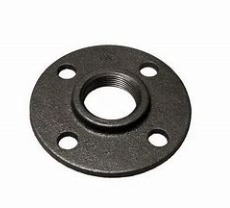In the intricate world of industrial engineering, Cast Iron Flanges are stalwart connectors. They forge a path of strength and reliability. This exploration delves into the realm of these robust components. It unravels their types, strength characteristics, and advantages. It also explains the meticulous practices involved in their maintenance.
What is a Cast Iron Flange?
At its essence, a Cast Iron Flange is a robust component designed to connect pipes, valves, or pumps. These flanges are crafted by casting molten iron. They exhibit remarkable durability and resistance, making them indispensable in various industrial applications.
Types of Cast Iron Flanges
A. Standard Flanges
1. Dimensions and Specifications
Standard Cast Iron Flanges adhere to specific dimensions and specifications. They ensure compatibility across a range of applications. The precise measurements contribute to their widespread use in diverse industrial settings.
2. Common Industrial Uses
These flanges find their footing in numerous industrial applications, from plumbing to manufacturing. Their adaptability makes them the go-to choice for creating reliable connections in standard configurations.
B. Specialty Flanges
1. Tailored Designs for Unique Applications
Specialty Cast Iron Flanges take customization to the next level. They offer tailored designs to meet the unique requirements of specific applications. This adaptability caters to industries with distinct needs.
2. Niche Industry Implementations
Specialty flanges find their niche in industries where standard configurations may not suffice. They’re used in aerospace and petrochemicals. Their bespoke designs ensure seamless integration into specialized systems.
Check out these other resources ⬇️⬇️⬇️
Butt Weld Flange: Unveiling The Diversity In Flange Types
Strength Characteristics of Cast Iron Flanges
A. Material Composition
1. Iron Alloys and Additives
Cast Iron Flanges boast a composition of iron alloys fortified with additives. This enhances their strength and resilience. This unique blend contributes to the durability and robustness of these components.
2. Impact on Durability and Performance
The carefully chosen material composition directly impacts the durability and performance of cast iron flanges. This results in components capable of withstanding extreme conditions and prolonged usage.
B. Resistance to Pressure and Temperature
1. Handling Extreme Conditions
Cast Iron Flanges showcase exceptional resistance to both high pressures and temperatures. This characteristic makes them ideal for applications. The environment demands components to endure challenging conditions.
2. Applications in Challenging Environments
Cast iron flanges are used in environments where pressure and temperature resistance are crucial. They are used in industrial boilers and high-pressure pipelines. This is crucial for sustained performance.
Advantages of Cast Iron Flanges
A. Longevity and Durability
1. Lifecycle Expectancy
The inherent longevity of cast iron flanges is a key advantage. Their robust construction ensures a prolonged lifecycle. This contributes to the overall reliability of the systems they serve.
2. Comparative Analysis with Other Materials
When compared to alternative materials, cast iron flanges often outshine in terms of durability. This comparative advantage positions them as a preferred choice in various industries.
B. Cost-Efficiency in the Long Run
1. Initial Investment vs. Maintenance Costs
The initial investment in cast iron flanges may be slightly higher. However, their extended lifespan and reduced maintenance costs make them cost-effective in the long run.
2. Economic Benefits for Industries
Industries that use cast iron flanges benefit from reduced downtime. They also enjoy lower replacement costs and a reliable infrastructure. This contributes to overall economic efficiency.
Maintenance and Inspection
A. Regular Checks for Wear and Corrosion
1. Visual Inspection Tips
Routine visual inspections are crucial for identifying early signs of wear and corrosion. Examining the surface for anomalies ensures proactive maintenance.
2. Frequency of Routine Maintenance
The frequency of maintenance checks depends on the operating conditions. Harsher environments may necessitate more frequent inspections to prevent extensive damage.
B. Repair and Replacement Guidelines
1. Identifying Signs of Flange Degradation
It’s imperative to recognize signs of degradation, like rust or surface irregularities. Doing so will help determine when repair or replacement is necessary. Early identification prevents catastrophic failures.
2. Steps for Safe and Effective Replacement
When replacement is needed, it is vital to follow industry guidelines for safe and effective removal and installation. Adhering to proper procedures ensures the continued reliability of the entire system.
Industry Standards and Compliance
A. Conformity to Regulatory Requirements
1. International Standards
Cast iron flanges must conform to international standards set by regulatory bodies. Compliance ensures uniformity in design and manufacturing, contributing to industry-wide safety.
2. Importance of Compliance for Safety
Adhering to regulatory standards is paramount for the safety of industrial operations. Compliance ensures that cast iron flanges meet established safety benchmarks. This minimizes risks and liabilities.
Frequently Asked Questions
What is the difference between cast iron and carbon steel flanges?
Cast iron flanges, crafted from iron alloys, offer exceptional durability and resistance. In contrast, carbon steel flanges are made primarily from carbon. They provide strength but have different characteristics.
What is the difference between cast flanges and forged flanges?
Cast flanges are formed through the casting process, while forged flanges are shaped by forging. The manufacturing process imparts distinct characteristics, influencing their applications and performance.
Conclusion
Industries find themselves equipped with components forged to last. They navigate the strength of cast iron flanges. Cast iron flanges are indispensable in industrial operations. They offer durability, resistance, and economic benefits. They come in standard and specialized designs.
As we explore different applications and factors, it becomes clear that cast iron flanges are more than components. They are enduring pillars that support the reliability and longevity of complex systems.
Post time: Feb-08-2024


